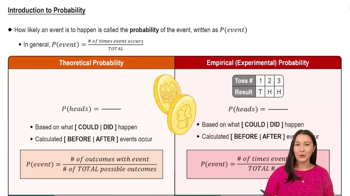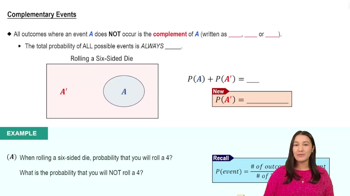34. Lottery Number Selection A lottery has 52 numbers. In how many different ways can six of the numbers be selected? (Assume the order of selection is not important.)
Table of contents
- 1. Intro to Stats and Collecting Data1h 14m
- 2. Describing Data with Tables and Graphs1h 55m
- 3. Describing Data Numerically2h 5m
- 4. Probability2h 16m
- 5. Binomial Distribution & Discrete Random Variables3h 6m
- 6. Normal Distribution and Continuous Random Variables2h 11m
- 7. Sampling Distributions & Confidence Intervals: Mean3h 23m
- Sampling Distribution of the Sample Mean and Central Limit Theorem19m
- Distribution of Sample Mean - Excel23m
- Introduction to Confidence Intervals15m
- Confidence Intervals for Population Mean1h 18m
- Determining the Minimum Sample Size Required12m
- Finding Probabilities and T Critical Values - Excel28m
- Confidence Intervals for Population Means - Excel25m
- 8. Sampling Distributions & Confidence Intervals: Proportion1h 12m
- 9. Hypothesis Testing for One Sample3h 29m
- 10. Hypothesis Testing for Two Samples4h 50m
- Two Proportions1h 13m
- Two Proportions Hypothesis Test - Excel28m
- Two Means - Unknown, Unequal Variance1h 3m
- Two Means - Unknown Variances Hypothesis Test - Excel12m
- Two Means - Unknown, Equal Variance15m
- Two Means - Unknown, Equal Variances Hypothesis Test - Excel9m
- Two Means - Known Variance12m
- Two Means - Sigma Known Hypothesis Test - Excel21m
- Two Means - Matched Pairs (Dependent Samples)42m
- Matched Pairs Hypothesis Test - Excel12m
- 11. Correlation1h 6m
- 12. Regression1h 50m
- 13. Chi-Square Tests & Goodness of Fit1h 57m
- 14. ANOVA1h 57m
4. Probability
Counting
Problem 3.4.44b
Textbook Question
Officers The offices of president, vice president, secretary, and treasurer for an environmental club will be filled from a pool of 14 candidates. Six of the candidates are members of the debate team.
b. What is the probability that none of the offices are filled by members of the debate team?
 Verified step by step guidance
Verified step by step guidance1
Step 1: Understand the problem. We are tasked with finding the probability that none of the four offices (president, vice president, secretary, and treasurer) are filled by members of the debate team. There are 14 candidates in total, 6 of whom are members of the debate team, leaving 8 candidates who are not members of the debate team.
Step 2: Calculate the total number of ways to assign the four offices. Since the order of selection matters (e.g., president is different from vice president), this is a permutation problem. The total number of permutations is given by the formula: .
Step 3: Calculate the number of favorable outcomes where none of the offices are filled by members of the debate team. Since there are 8 candidates who are not members of the debate team, we calculate the number of permutations of 4 offices from these 8 candidates using the formula: .
Step 4: Compute the probability that none of the offices are filled by members of the debate team. The probability is the ratio of the number of favorable outcomes to the total number of outcomes: .
Step 5: Simplify the probability expression and interpret the result. This will give you the likelihood that none of the offices are filled by members of the debate team. Ensure you understand that this probability is based on the assumption that all candidates are equally likely to be chosen.
 Verified video answer for a similar problem:
Verified video answer for a similar problem:This video solution was recommended by our tutors as helpful for the problem above
Video duration:
4mPlay a video:
Was this helpful?
Key Concepts
Here are the essential concepts you must grasp in order to answer the question correctly.
Probability
Probability is a measure of the likelihood that a particular event will occur, expressed as a number between 0 and 1. In this context, it involves calculating the chance that none of the selected candidates for the club offices are members of the debate team. Understanding how to compute probabilities is essential for solving the question.
Recommended video:

Introduction to Probability
Combinatorics
Combinatorics is a branch of mathematics dealing with combinations and permutations of objects. In this scenario, it is crucial to determine how many ways the offices can be filled from the pool of candidates, specifically focusing on the selection of candidates who are not members of the debate team. This concept helps in calculating the total possible outcomes.
Complementary Events
Complementary events are pairs of outcomes where one event occurs if and only if the other does not. In this question, the event of interest is that none of the offices are filled by debate team members, which can be analyzed by considering the complementary event of at least one office being filled by a debate team member. This understanding aids in simplifying the probability calculations.
Recommended video:

Complementary Events

 7:11m
7:11mWatch next
Master Introduction to Permutations with a bite sized video explanation from Patrick
Start learningRelated Videos
Related Practice
Textbook Question
